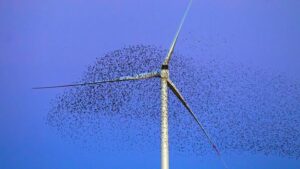GS3 – Environment

Context:
A recent study published in Nature Scientific Reports has identified wind farms in Rajasthan’s Thar Desert as having the highest bird mortality rates globally.
Key Findings:
- Severe Mortality Rate:
Approximately 4,464 bird deaths per 1,000 sq. km annually were reported, with an average of 1.24 bird deaths per turbine per month in the Thar region. - Major Contributing Factors:
- Strategic Location: The Thar Desert lies along the Central Asian Flyway, a crucial migratory route.
- Infrastructure Hazards: Poor turbine designs and collisions with overhead power lines contribute to fatalities.
- High Raptor Density: Species like eagles and kites, which are abundant in the region, are particularly vulnerable.
- Species-Specific Vulnerabilities:
Large raptors face greater threats due to:- Limited flight manoeuvrability
- Slow reproduction rates
- Long life spans, making population recovery slow
Proposed Mitigation Measures:
- Enhanced Blade Visibility:
- Painting one blade of the turbine black has proven effective in reducing bird collisions.
- Timed Operational Shutdowns:
- Temporarily halting turbine activity during peak bird migration seasons can significantly reduce deaths.
- Eco-sensitive Site Selection:
- Avoid installing wind farms in biodiversity hotspots and critical flyways to safeguard bird populations.
India’s Wind Energy Sector
- Installed Capacity (as of mid-2025):
India has reached an installed wind energy capacity of 51.3 GW (Source: MNRE). - Total Potential:
As per the National Institute of Wind Energy, the country possesses a gross wind energy potential of 1163.9 GW at a hub height of 150 metres. - Offshore Wind Ambitions:
Under the Offshore Wind Policy, India targets 30 GW of offshore wind capacity by 2030, reinforcing its commitment to green energy.




